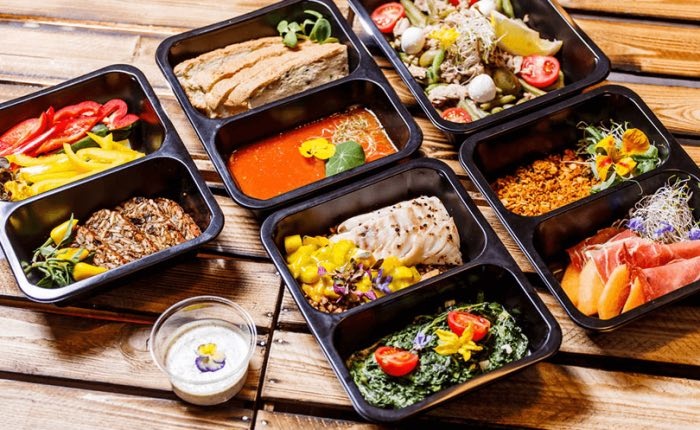Oh that dreaded feeling – after a long day at the office to get home and hear the question, “What’s for dinner? I’m starving.” If this makes you want to throw up your hands and run for cover, you may have already considered adding a meal delivery system to your routine. But is it worth the cost? Do the health benefits make up for it? Just like any subscription service, you should weigh your options and cost against your budget to help make your decision.
Meal kits are recipes and ingredients packaged up in the exact quantities, and can be shipped directly to your home (from companies such as Blue Apron, Home Chef or Plated). The key here is convenience, since in reality you can follow the traditional route of finding a recipe in a cookbook or online, making your grocery list, heading to the store to buy all the ingredients and making the meal from scratch. Meal kits package up this process by delivering the exact recipe (already tested out with beautiful/delicious pictures included), the exact amount of ingredients in one box, all delivered to your doorstep – usually for a monthly subscription charge.
If you think this sounds well worth it, you’re not alone. The US meal kit industry is about a $3 billion segment and saw YOY growth of about 22%, while expecting double-digit sales gains over the next several years. (1) The prices on a meal can range from $10 on up, but you have to be aware of any delivery charges and automatic billing cycles. Meal kits are certainly a healthier alternative than eating out (as shown by one study claiming restaurant food has more fat, cholesterol, sodium and calories than home-cooked meals), (2) but it is also no surprise they can get costly.
Dave Ramsey provides a breakdown of 3 meal kit recipes compared to buying the ingredients at the grocery store. Here is what he found: (3)
- Chicken Sausage Pizza:
o Grocery Store: $18.77 for four servings / $14.13 for two servings
o Meal Kit Service: $39.96 for four servings / $19.98 for two servings - Meatloaf with Sweet Potatoes and Green Beans
o Grocery Store: $26.81 for four servings / $20.24 for two servings
o Meal Kit Service: $39.96 for four servings / $19.98 for two servings - Chicken Orzo with Zucchini and Tomatoes
o Grocery Store: $22.30 for four servings / $17.17 for two servings
o Meal Kit Service: $39.96 for four servings / $19.98 for two servings
It is clear that buying the ingredients from the store is consistently a better cost option than a meal kit service, but the variance depends on the recipe. For example, it is much more cost effective to buy and make the ingredients for a pizza but not as much for meatloaf (especially for only 2 servings!).
When weighing your options on whether a meal kit delivery service is right for you, keep in mind the type of meals you’re looking to add to your rotation. This could be an opportunity to try out some new food groups, recipes or cooking methods in the kitchen.
Another note on Dave Ramsey’s cost comparison is the difference between serving sizes. Even if you’re making dinner for 2, it can often be more cost effective to go with the serving size for 4 and keep the left-overs for the next day. That way, you can get 2 meals out of 1 without a huge difference in price.
Also don’t forget the ingredients. With a meal kit, you will receive the exact amount of ingredients needed for that particular recipe. If you buy the ingredients from the store, you’ll likely have left-overs you can use for something else (or to make that meal again in the near future). The cost analysis above doesn’t necessarily factor in the ingredient “serving size.” Also don’t forget, you’ll likely still need to go to the store to buy other necessities, so a meal kit delivery subscription will most likely not completely replace this errand, but rather supplement it.
There is a ton of meal delivery kit options available so if this is something you’re looking to add to your weekly menu and budget, be sure to evaluate all of your choices. Some may have different food groups you’re interested in, while others may have a different cost structure. With so many different priorities and situations, it’s critical to find the one that’s best for you and your family.
But wait – there’s another option if you really don’t feel like turning on that stove. Meal delivery services such as Uber Eats, GrubHub or Door Dash are also changing the game on the “what’s for dinner” question. On those nights when you just don’t feel like cooking, the traditional route would be to just order take-out and call it a night. But now with food delivery apps, you can order almost anything right from your phone, all for a minimal delivery fee (and typically pretty quick).
Although meal delivery is still a relatively new market, meal delivery platforms have hit $120 billion in gross food sales globally (being led by China, with 64% of global market share), and most meal delivery companies are growing at a rate of 40%+ each year. (4)
The takeaway here is that in our fast-paced, on-the-go, mobile-centric society, you have many options on how you can go about your meal prepping. But before you sign up, make sure you weigh your priorities to find the best meal option for you. Depending on whether you’re looking for nutritional benefits, cost savings or experimenting with some new dishes in the kitchen, you can almost always find a good fit.
No more boring weekday meals - now you have countless options to maximize convenience, nutrition and enjoyment in preparing those dinners. Happy Cooking!
(1) https://www.supermarketnews.com/online-retail/meal-kit-players-adapt-changing-market
(2) https://www.moneyunder30.com/meal-delivery-comparison
(3) https://www.daveramsey.com/blog/meal-delivery-service-worth-it
(4) https://ark-invest.com/research/food-as-a-service-the-3-trillion-meal-delivery-market
